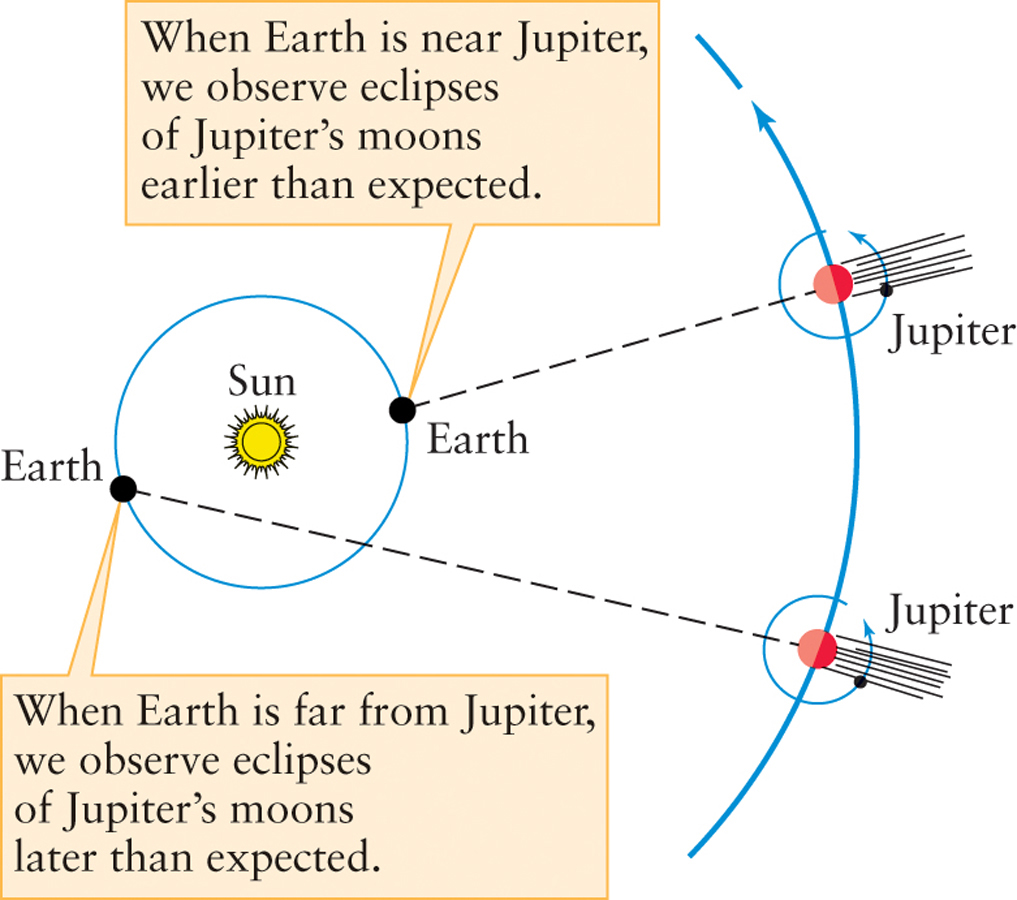2-1 Light travels through empty space at a speed of nearly 300,000 km/s
When you turn on a flashlight or a laser pointer, how long does it take for the beam to move across the room? Most people would agree that light moves quite quickly, but how would you actually measure this? Consider the following experiment: You and a partner stand on opposite sides of a room and point flashlights at one another. The agreement is that you are going to turn your flashlight on first, and when your partner receives your flashlight beam, she will turn on her flashlight aimed back at you. Your task is to measure how much time elapses between when you first send a beam of light across the room and when you see the other flashlight beam travel back to you. Does this seem possible?
In the early 1600s, Galileo tried to measure the speed of light using a similar approach. He and an assistant stood at night on two hilltops a known distance apart, each holding a shuttered lantern. First, Galileo opened the shutter of his lantern; as soon as his assistant saw the flash of light, he opened his own. Using his pulse as a timer, Galileo found that the measured time failed to increase noticeably, no matter how distant the assistant was stationed. Galileo therefore concluded—as you most likely did—that the speed of light is too high to be measured by slow human reactions.
Nearly 70 years after Galileo, the Danish astronomer Olaus Rømer was studying the orbits of the moons of Jupiter by carefully timing the moments when they passed into or out of Jupiter’s shadow. To Rømer’s surprise, the timing of these eclipses of Jupiter’s moons seemed to depend on the relative positions of Jupiter and Earth. When Earth was far from Jupiter (Figure 2-1), the eclipses occurred several minutes later than when Earth was close to Jupiter.

Rømer realized that when Earth is closest to Jupiter, the image of a moon disappearing behind Jupiter arrives at our telescopes a little sooner than it does when Jupiter and Earth are farther apart. Rømer was not able to actually calculate the speed of light because he did not know the exact distances Earth was moving closer and farther from Jupiter, but using our modern understanding of these distances, Rømer’s method yields an impressively correct value for the speed of light.
The speed of light in a vacuum is usually designated by the letter c (from the Latin celeritas, meaning “speed”). The current accepted value of the speed of light is c = 299,792.458 km/s (186,282.397 mi/s) but is slightly slower when traveling through a transparent substance such as air, water, or glass. The value in kilometers per second (km/s) is often most useful when comparing c to the speeds of objects in space, though the most convenient set of units to use for c is different in different situations. The speed of light in a vacuum is a universal constant: It has the same value everywhere in the cosmos. In most calculations, you can use:
c = 300,000 km/s
Indeed, light moves almost unimaginably fast, fast enough to circle Earth almost 7 times in a single second. Light takes only a little more than a second to travel all the way to the Moon, 240,000 mi (384,000 km). Today, the speed of light in empty space is well known, and one of the most important numbers in modern physical science. This value appears in many equations that describe atoms, gravity, electricity, and magnetism. It is also an upper limit on speed: According to Einstein’s special theory of relativity, nothing can travel faster than the speed of light.
Question
ConceptCheck 2-1: Why has the speed of light been historically so difficult to measure?
Answer appears at the end of the chapter.
35